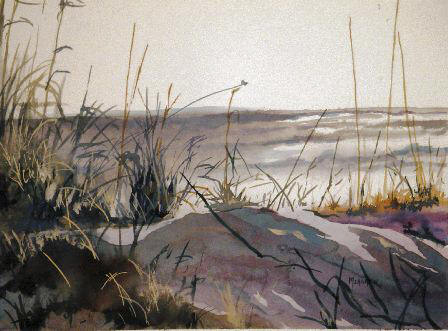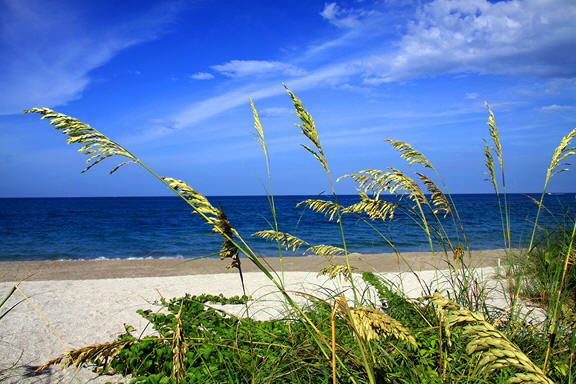Discover Florida Nature
It's time to explore the natural Florida


|
|
|
|
|
 Florida
has a longer coastline facing the Gulf of Mexico than the Atlantic
Ocean. With 580 miles along the Atlantic Ocean and 770 miles along the
Gulf of Mexico the state of Florida has a total of 1,350 miles of
coastline! When driving down Route AlA, it is hard to imagine that the
South Florida coastline was once a continuous strip of native
vegetation. It is even harder to imagine the abundant wildlife that once
roamed its shoreline such as sea turtles,
the
Florida panther and
black bears. These displaced and
extirpated animals lived along with native plants in the natural coastal
dune ecosystems that were maintained by periodic storms, hurricanes and
fire. Florida
has a longer coastline facing the Gulf of Mexico than the Atlantic
Ocean. With 580 miles along the Atlantic Ocean and 770 miles along the
Gulf of Mexico the state of Florida has a total of 1,350 miles of
coastline! When driving down Route AlA, it is hard to imagine that the
South Florida coastline was once a continuous strip of native
vegetation. It is even harder to imagine the abundant wildlife that once
roamed its shoreline such as sea turtles,
the
Florida panther and
black bears. These displaced and
extirpated animals lived along with native plants in the natural coastal
dune ecosystems that were maintained by periodic storms, hurricanes and
fire.Florida is defined by its beaches. They are one of our most important natural resources. But Florida’s beaches are in trouble – from sand loss due to inlets and jetties, poorly sited coastal development, inadequate coastal construction setback policies, sea wall construction, stronger and more frequent erosion-causing storms, and slow-rising sea levels. Beach erosion is a major concern on the highly developed west-central Florida coast. The region between Anclote Key in southern Pasco County and Venice Inlet in central Sarasota County contains 18 barrier islands and inlets spanning 130 km of coastline, much of which has undergone significant change within the past century. Under natural conditions, barrier islands shift in response to storms, sediment supply, and changes in sea-level. Manmade structures such as sea walls, jettys, and even buildings and roads can alter the influence of these natural processes. Consequently, some areas have experienced rapid beach erosion, resulting in narrow beaches that are insufficient for recreational use or protection of upland properties. The west-central Florida coast barrier-island chain sits near the center of a broad, gently sloping carbonate platform. The continental shelf is underlain by limestone bedrock with a thin, discontinuous cover of sand deposits of both quartz and carbonate origin. Prior to the initiation of this project, it was generally believed that sand resources were evenly distributed on the continental shelf. Early results, however, have demonstrated that sand is concentrated in specific, near shore areas and is of limited thickness.  Florida
beaches are at sea level on both the Atlantic Ocean side of the
peninsula, and on the Gulf of Mexico. Scenic hills and sand cliffs
dividing the flat beach from the inland areas are called sand dunes.
Sand dunes are born when wind and waves from the ocean (or gulf) deposit
organic matter onto the sand. The matter embeds in the sand and begins
to grow. During the summer, more and more sand is trapped by the
propagating plant life. Low-growing tough plants with extensive root
systems (called rhizomes) develop, preventing small dunes from breaking
down during high tide. As the growing process continues, larger plants
trap more sand. More sand grows larger plants. Year after year the cycle
continues. Sea oats, palmetto plants, sea grapes, and cabbage palms are
among the many plant varieties that inhabit older dunes. Some of the
biggest sand dunes support trees, like pine and live oak. Of all the
plants found on the beaches, sea oats are the most popular. Florida
beaches are at sea level on both the Atlantic Ocean side of the
peninsula, and on the Gulf of Mexico. Scenic hills and sand cliffs
dividing the flat beach from the inland areas are called sand dunes.
Sand dunes are born when wind and waves from the ocean (or gulf) deposit
organic matter onto the sand. The matter embeds in the sand and begins
to grow. During the summer, more and more sand is trapped by the
propagating plant life. Low-growing tough plants with extensive root
systems (called rhizomes) develop, preventing small dunes from breaking
down during high tide. As the growing process continues, larger plants
trap more sand. More sand grows larger plants. Year after year the cycle
continues. Sea oats, palmetto plants, sea grapes, and cabbage palms are
among the many plant varieties that inhabit older dunes. Some of the
biggest sand dunes support trees, like pine and live oak. Of all the
plants found on the beaches, sea oats are the most popular. The Florida coastline is at sea level. Without sand dunes, there would be no white sandy beaches for tourists and residents to enjoy. The daily rise and fall of the tides, and frequent summer storms continually change the profile of the beaches. During this natural cycle the plants on the dunes harbor sand. This 'reserve' sand supply replenishes the lower beach sand as the wind and water take it away. Additionally, the lowest dunes provide a habitat for sea turtle eggs, sand crabs, and other marine creatures. Dunes play an important role both to the beaches that front them and the land behind them. Dunes act as a sand reserve for beaches. Dunes provide a barrier to salt intrusion from high tides and storm surges, and it protects the land behind the dunes from erosion. Photographers, artists, and sunbathers alike can never seem to get enough of the Atlantic beaches that stretch for hundreds of miles, or the pristine beaches and emerald waters of the gulf coast. Keep in mind that the fabulous scenery is made possible by the sand dunes protecting the coastline. Without the sea oats and other plant life, the sand dunes would not exist. Enjoy the sun, collect shells, and take as many photos as desired, but leave the sea oats and other wild plant life intact. Preserve the beaches for generations to come by staying informed and obeying the laws protecting the coastal environment. |
|
|
Advertise | Privacy Statement | Dog Encyclopedia | Video |Contact | Alaska Nature |
|